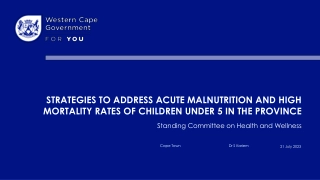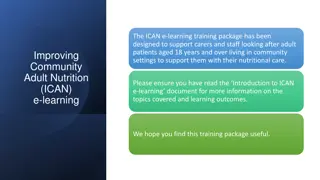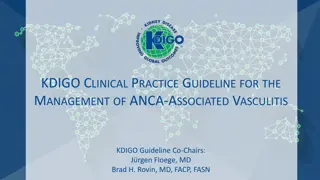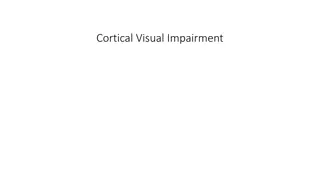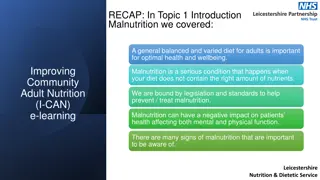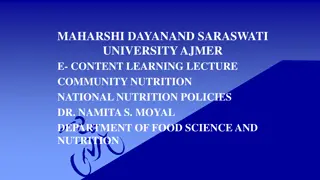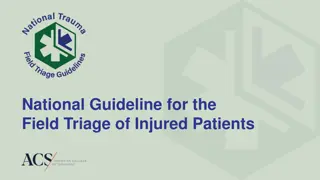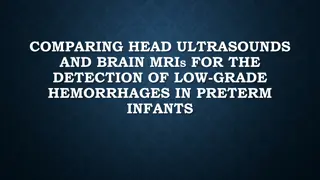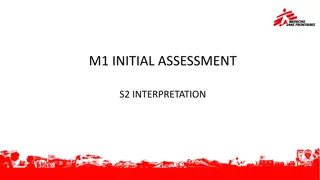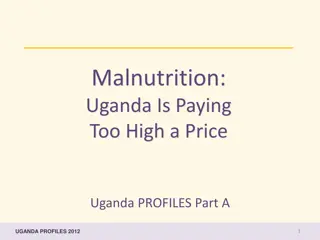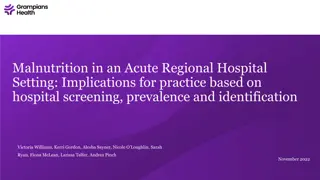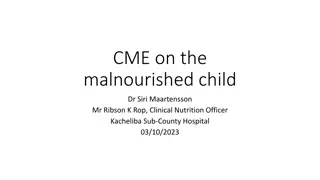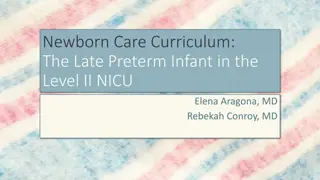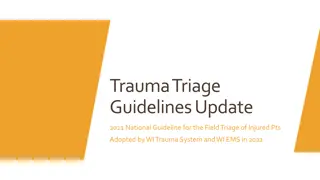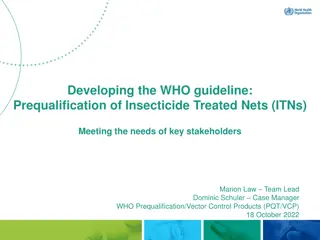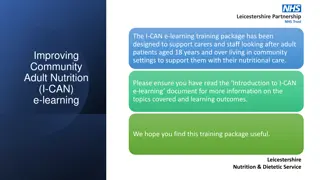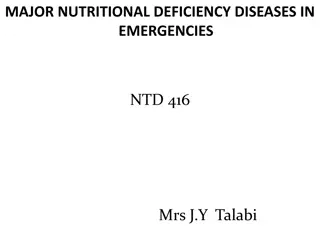WHO Guideline: Prevention & Management of Malnutrition in Infants & Children
Key insights from WHO's guideline on managing wasting and malnutrition in children under 5. Covers assessment, care for infants and mothers, and treatment strategies for different malnutrition levels
Download Presentation

Please find below an Image/Link to download the presentation.
The content on the website is provided AS IS for your information and personal use only. It may not be sold, licensed, or shared on other websites without obtaining consent from the author. Download presentation by click this link. If you encounter any issues during the download, it is possible that the publisher has removed the file from their server.
E N D
Presentation Transcript
WHO guideline on the prevention and management of wasting and nutritional oedema (acute malnutrition) in infants and children under 5 years
Housekeeping Please ask questions in the Q&A box and not in the chat A recording of this webinar will be available in due course Translation is accessible by clicking the globe icon on the bottom of your screen. La traduction est accessible en cliquant sur l'ic ne du globe terrestre au bas de votre cran. Se puede acceder a la traducci n haciendo clic en el icono del globo en la parte inferior de la pantalla.
Speakers Speakers Q&A Moderator Grainne Maloney Nutrition and Child Development Programme Group, UNICEF HQ Zita Weise Prinzo Department of Nutrition & Food Safety, WHO HQ Allison Daniel Department of Nutrition & Food Safety, WHO HQ Jaden Bendabenda Department of Nutrition & Food Safety, WHO HQ Kirrily de Polnay Department of Nutrition & Food Safety, WHO HQ Minh Tram Le Nutrition and Child Development Programme Group, UNICEF HQ Grace Funnell Nutrition and Child Development Programme Group, UNICEF HQ
Objectives Brief introduction to the recommendations and good practice statements of the management section of the new WHO guideline Next steps in terms of: Operational guidance Research gaps consolidation Dissemination country assessments and updates of national protocols/guidelines
Key messages (management section) Nutritional status must not be seen in isolation. Assessment of an infant s or child s health is key for decision-making. Mothers and their infants less than six months at- risk of poor growth and development must be identified early and cared for as an inter- dependent unit. Sensitive and effective care of infants and their mothers is one of the most effective preventative actions of all.
Key messages (management section) Not all children with MAM need a specially formulated food to supplement their diet. Risk-factors to proritise which MAM children to consider for SFFs (high-risk contexts -such as humanitarian crises- as well as specific individual or social factors) Children with SAM should receive nutritional treatment with an RUTF that meets the Codex specification. Amount RUTF given can be either constant until anthropometric recovery or reduced after reaching MAM (depends on capacity and context)
Key messages (management section) CHWs can manage children 6-59 months of age with acute malnutrition in the community as long as they are adequately trained and receive ongoing supervision and support. Countries must be supported to adopt these recommendations taking into account their specific contexts, needs and capacities at national and sub-national levels.
Terminologies WHO Guideline document title: Prevention and Management of Wasting and Nutritional Oedema (Acute Malnutrition) WHO Guideline document text: wasting and/or nutritional oedema moderate wasting severe wasting and/or nutritional oedema See section on Definitions and Terminologies in the Introduction section of the Guideline. UNICEF-WHO Operational guidance: MAM SAM
Scope of the guideline Management section release: July 2023 Full guideline publication (management and prevention): Q3/Q4 2023
Guiding principles Child health approach Mother-infant pair Multisectoral action Health system focus Nutritious home foods Gender equity Local adaptation www.childwasting.org/normative-guidance
Child health approach What does the child need? Wherever a child presents, they get ALL the services they need. We need to work together to support services which work around the child, and not programmes which we try to fit children and their families into.
Sub-sections of the guideline A. Infants less than 6m of age at risk of poor growth and development B. Infants and Children 6-59m with wasting and/or nutritional oedema C. Post-exit interventions after recovery from wasting and/or nutritional oedema D. Prevention
Read the remarks! Interpretation Implementation
Section A: Infants less than 6 months of age at risk for poor growth and development
Section A: Infants less than 6 months of age at risk for poor growth and development Criteria NOT definition LBW SGA Preterm MUAC <110mm 6w to <6m WAZ <-2 WLZ <-2 Nut oedema
Summary of recommendations and GPS Mothers/caregivers and infants receive regular care and monitoring by health professionals Criteria for: Inpatient admission Outpatient enrollment In-depth assessment (IP/OP?) Reduced frequency of follow-up and final assessment at 6 months of age Comprehensive assessments of breastfeeding challenges Supplemental milk decisions and types Maternal support for physical and mental health and well-being
Section B: Severe acute malnutrition (SAM)
A few definitions Glossary! Nutritional Supplementation MAM We are supplementing a child with MAM s diet to meet their full nutrient needs for recovery not providing SFFs to meet their full needs. Nutritional Treatment SAM We are providing RUTF in an amount to meet their full nutrient needs for recovery. We are treating them.
SAM: Summary of recommendations and GPS Emphasising importance of triage and overall health assessment Criteria for: Inpatient admission Outpatient Enrollment In-depth assessment (IP/OP?) Transfer Inpatient to outpatient Exit from nutritional treatment Medical problems defined Dehydration assessment and type of rehydration fluids Hydrolysed milks (IP) Quantity of RUTF (constant or reduced)
Section B: Moderate acute malnutrition (MAM)
Priorities for moderate wasting Accessing nutrient dense home diet for healthy growth Assessing and treating medical problems IF NOT POSSIBLE Accessing appropriate specially formulated foods (SFFs)
MAM: Summary of recommendations and GPS Not all children with MAM need a specially formulated food (SFF) to supplement their diet. All children with MAM need a health assessment to rule out medical problems that could be the cause or main driver of the MAM. All children with MAM need access to a nutrient-dense home diet to meet their energetic and nutrient needs. Some children with MAM have risk factors which make them more likely to die or not recover than others. These risk factors are related to whether they live in a high-risk context (such as humanitarian crises) as well as specific individual or social factors. These factors can be used to consider which children with MAM should be prioritized to receive SFFs to supplement their home diet. SFFs can be RUTF, RUSF or an improved fortified blended food. All children 6-59m with MAM need 100-130kcal/kg/day to recover from MAM (non-malnourished 80kcal/kg/d). 40-60% of this should be covered by a SFF (if giving a SFF).
Shift in focus We are supplementing only 40-60% of the child s needs WE NEED TO ENSURE THE OTHER 60-40% IS COVERED! We are not treating MAM need to shift our language, policies and protocols The most sustainable approach is LOCAL/HOME FOODS GAP PARTNERS AND FRAMEWORK!
What advice can we give for a nutrient-dense home diet? Energy: Total daily energy requirements 100-130 kcal/kg/day to recover Nutrients: MAM Technical Note NutVal? Other programmes? Food rations? Local Recipes? World Health Organisation. Technical note: supplementary foods for the management of moderate acute malnutrition in infants and children 6 59 months of age. 2012
Section B: Management by CHWs
Management by CHWs Recommendation B6 Assessment, classification, and management or referral of infants and children 6-59 months of age with wasting and/or nutritional oedema can be carried out by community health workers as long as they receive adequate training, and regular supervision of their work is built into service delivery. No adequate training and supervision = no CHW management of MAM or SAM Nutritional Supplementation for MAM Nutritional Treatment for SAM kcal/kg/day
Section C: Post-exit interventions
Post-exit interventions Reinforcing the importance of a comprehensive approach to post-exit interventions Counselling and education Support to provide responsive care Safe WASH interventions Psychosocial stimulation starting during treatment and continuing after exit Cash transfers as an option for children who were admitted/enrolled with SAM to decrease relapse Assess feasibility & cost
Publication on MagicApp Full pdf with all sections Q3/Q4
Operational guidance Research gaps Dissemination and implementation Next steps:
Operational guidance Regional level National level How to assess what is needed/ feasible in a context and implement the recommendations Operational Guidance District level Guidance for Programme Managers Guidance for Health Care Workers Guidance for Policy-Makers Policy briefs Advocacy materials and tools Setting up and running services Monitoring quality Updated Manual in a modular format Training tools Clinical decision- making tools
Health Worker Ops Guidance CHWs Inpatient Outpatient Implementation Guidance LBW/prem GL Baby-Friendly Hospital Initiative MAM MAM MAM INTEGRATION IMCI SAM SAM SAM iCCM Infants <6m Infants <6m Prevention WHO Pocket Book Hospital Management Prevention Prevention
Research Identify research gaps Identify important aspects of protocol design Evidence to Decision making process (GRADE)
Core group = 19 Country representation and CSOs Subgroups ops guidance, research, CHWs, definitions and terminologies https://www.who.int/groups/unicef-who-technical-advisory-group-on-wasting-and-nutritional-oedema-(acute-malnutrition)
Dissemination and local adaptation Working with countries to integrate recommendations and operational guidance into national HEALTH AND NUTRITION policies, protocol and guidance (N4G Commitment) With our UN partners GAP Stakeholder meetings regional and country
Thank you for your attention! Questions?





